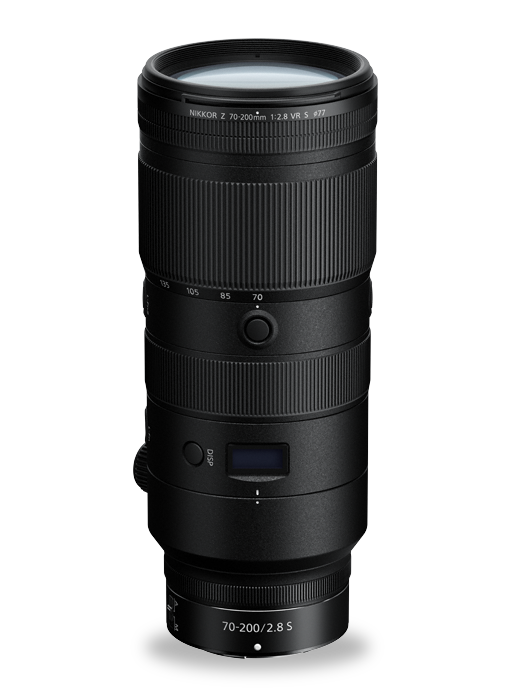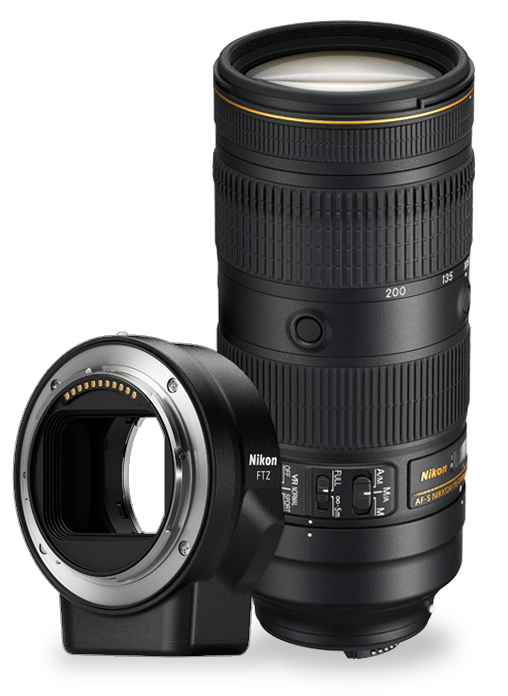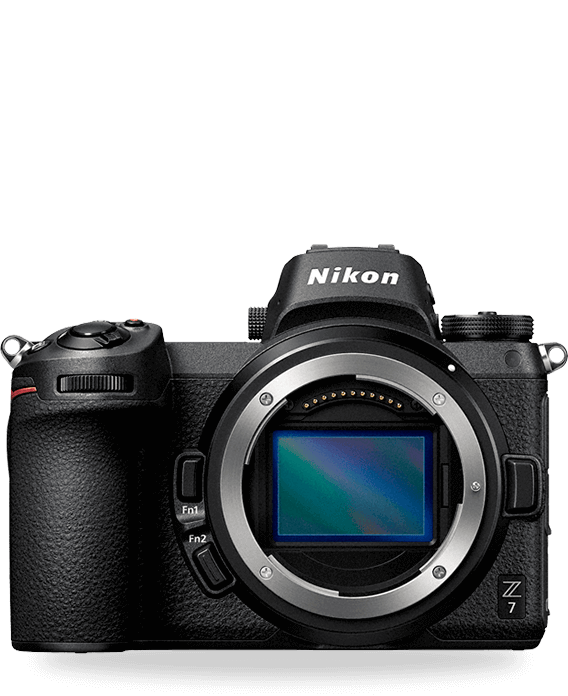Obsession du détail.

Tout est dans les détails. Un zoom sans concessions.
Vidéo de qualité cinéma.
Le NIKKOR Z 70-200mm f/2.8 VR S est un objectif sensationnel pour la vidéo. L’autofocus est fluide, silencieux et ne génère presque aucun effet de respiration. L’objectif peut accueillir un filtre 77 mm standard. La stabilisation d’image optique de qualité supérieure vient s’associer à la stabilisation du boîtier* et à la VR électronique. Tout ceci dans un objectif polyvalent, qui vous permet d’aller de 70 à 200 mm. * La stabilisation d’image intégrée au boîtier n’est pas disponible sur l’ensemble des appareils photo de la série Z.
L’avantage Nikkor Z
| Características del lente | 
Nikkor Z
|

Nikkor(avec l’adaptateur |
|---|---|---|
Stabilisation d’image intégrée au boîtier |
5 axes*/5,5 vitesses |
3 axes/4 vitesses |
Bruit de l’autofocus |
Quasiment éliminé |
Presque inaudible |
Système de mises au point multiples |
||
Min. Distance de mise au point |
0,5 m (G) - 1,0 m (T) |
1,1 m |
Lentilles asphériques intégrées |
2 |
0 |
Lentille en verre à forte dispersion spécialisée (SR) |
1 |
0 |
Revêtement antireflet |
Nano + ARNEO |
Nano |
Effet de respiration de la mise au point réduit |
||
Bague de contrôle personnalisable |
||
Adaptateur de monture offert en option |
Requis |
|
Diamètre de la montura/Distance des ailettes |
55 mm |
47 mm |
Technologie

Verre ED (à dispersion extra faible)
Un verre optique développé par Nikon et utilisé avec du verre optique normal sur les téléobjectifs, afin d’obtenir une correction optimale des aberrations chromatiques.

Revêtement ARNEO
Un revêtement antireflet conçu par Nikon et utilisé conjointement avec le traitement nanocristal pour réduire encore davantage les images fantômes et les lumières parasites causées par l’entrée verticale de lumière incidente dans l’objectif. Cela permet une capture d’images remarquablement claire lorsqu’une source lumineuse est située dans le cadre.

Mécanisme de diaphragme électromagnétique
Un mécanisme de diaphragme électromagnétique situé dans le barillet de l’objectif permet d’obtenir une extrême précision pour le contrôle électronique du diaphragme ou des lamelles d’ouverture lors de l’utilisation de l’exposition automatique dans une prise de vue continue.

AS
AS désigne les lentilles asphériques. Ce type de lentille comprend des surfaces non sphériques sur l’un ou les deux côtés du verre afin d’éliminer certains types d’aberrations.

Revêtement en fluorine
Les photographes ont besoin d'un équipement en mesure de résister aux éléments. Le revêtement en fluorine de Nikon repousse efficacement la poussière, les gouttelettes d'eau, la graisse ou la saleté, assurant un retrait facile même lorsqu'elles adhèrent à la surface de l'objectif. Le revêtement en fluorine de Nikon résiste à l'essuyage fréquent de la surface de l'objectif et son effet antireflet rend également les photos plus nettes.

Traitement nanocristal
Revêtement antireflet développé par Nikon, permettant d’éliminer pratiquement tous les reflets sur les éléments internes de l’objectif, sur une très large plage de longueurs d’onde.

Traitement super intégré
Le traitement super intégré de Nikon est le terme employé par Nikon pour désigner le traitement multicouche des éléments optiques contenus dans les objectifs NIKKOR.

Réduction de vibrations
Une technologie intégrée de Nikon destinée à améliorer la stabilité de l’image par compensation automatique des tremblements de l’appareil. Les objectifs dotés du système VR affichent l’abréviation VR sur leur canon.

Objectif IF
Un objectif NIKKOR dans lequel seul le groupe de lentilles interne se déplace lors de la mise au point. Ainsi, les objectifs IF NIKKOR ne s’allongent pas pendant l’autofocus, ce qui permet d’obtenir des distances de mise au point plus rapprochées de la part d’un objectif plus compact et plus léger. Ce type d’objectifs est désigné par l’abréviation IF située sur le canon.

Moteur pas à pas
Les objectifs NIKKOR Z utilisent un moteur pas à pas pour un autofocus silencieux, rapide et tout en douceur avec réduction de l’oscillation. Grâce à ce système silencieux, l’utilisation de ces objectifs est idéale lors de la prise de vidéos.

Lentille réfractive à courte longueur d'onde
SR est une lentille en verre à dispersion élevée et spécialisée qui réfracte la lumière avec des longueurs d'onde plus courtes que celle du bleu. En contrôlant la lumière à courte longueur d'onde, l'objectif est capable d'obtenir une compensation d'aberration chromatique très précise afin que les couleurs de vos images soient reproduites avec plus de précision. Il permet également des conceptions optiques plus flexibles, ce qui permet de concevoir des objectifs compacts et plus légers.

Élément de lentille en fluorite
La fluorite (FL), un matériau optique monocristallin léger, possède d'excellentes propriétés optiques tout en réduisant le poids global de l'objectif pour améliorer l'équilibre et la maniabilité, particulièrement utile dans les lentilles à distance focale plus longue.
Basado en la norma CIPA: este valor se genera al colocarlo en una cámara de formato FX con la función VR de la cámara configurada en "NORMAL" y el zoom en máxima posición telefotográfica.
Les images des écrans ACL et des galeries photo et vidéo sont fournies à titre illustratif uniquement
Caractéristiques techniques
Plage de Longueurs Focales
70 -200mmOuverture Maximale
f/2.8Format
FXStabilisation d'Image VR (Réduction de Vibration)
OuiRevêtement Nano Cristal
OuiDimensions Approx. (Diamètre x Longueur)
3.6 in.89 mmx8.7 in.220 mmPoids Approx.
48 oz.1360 g
- Type de MontureMonture Nikon Z
- Plage de Longueurs Focales70 -200mm
- Rapport de Zoom2.9x
- Ouverture Maximalef/2.8
- Ouverture Minimalef/22
- FormatFX
- Angle de Vue Maximum (format DX)22° 50′
- Angle de Vue Minimum (format DX)8°
- Angle de Vue Maximum (format FX)34° 20′
- Angle de Vue Minimum (format FX)12°20′
- Rapport de Reproduction Maximum0,2x
- Éléments de l'objectif21
- Groupes de l'Objectif18
- Format(s) Compatible(s)FX, DX
- Stabilisation d'Image VR (Réduction de Vibration)Oui
- Lames de Diaphragme9
- Information sur la DistanceOui
- Revêtement ArneoOui
- Revêtement Nano CristalOui
- Éléments en Verre ED6
- Éléments en Fluorite1
- Revêtement de FluorineOui
- Éléments Asphériques2
- Revêtement Super IntégréOui
- AutofocusOui
- Mise au Point InterneOui
- Distance Minimale de Mise au Point0,5 m (1,64 pi) à la position de zoom réglée sur 70 mm, 0,63 m (2,07 pi) à la position de zoom réglée sur 85 mm, 0,68 m (2,23 pi) à la position de zoom réglée sur 105 mm, 0,8 m (2,62 pi) à la position de zoom réglée sur 135 mm, 1,0 m (3,28 pi) à la position de zoom réglée sur 200 mm
- Mode de Mise au PointAuto/manuel
- Taille du Filtre77mm
- Type de Filtre AcceptéÀ visser
- Dimensions Approx. (Diamètre x Longueur)3.6 in.89 mmx8.7 in.220 mm
- Poids Approx.48 oz.1360 g
- Type d'ObjectifZoom
Assistance
Enregistrement de produit
L’enregistrement de votre produit Nikon nous permet de vous envoyer (avec votre permission) des mises à jour importantes, des renseignements sur le service et des conseils utiles. Cela simplifie par ailleurs les procédures dans l’éventualité où vous auriez besoin de nous appeler pour obtenir de l’aide.
Enregistrez votre produit en ligne maintenant.Site Réponses Nikon
Nous stockons tous les problèmes résolus dans notre base de données de solutions. Si vous n’y trouvez pas la réponse qui vous convient, envoyez votre question à notre équipe d’assistance technique.
Visualiser les Questions et réponses



